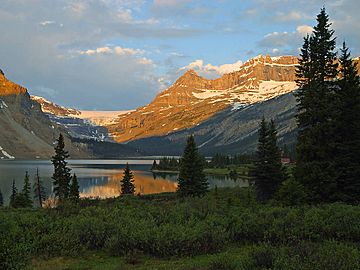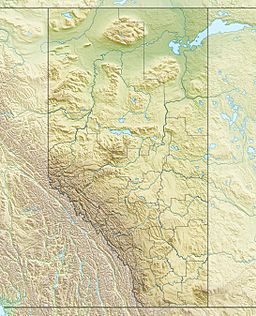Portal Peak facts for kids
Quick facts for kids Portal Peak |
|
|---|---|

Portal Peak from Icefields Parkway at Bow Lake
|
|
| Highest point | |
| Elevation | 2,926 m (9,600 ft) |
| Prominence | 86 m (282 ft) |
| Parent peak | Mount Thompson (3089 m) |
| Listing | Mountains of Alberta |
| Geography | |
| Location | Alberta, Canada |
| Parent range | Waputik Mountains Canadian Rockies |
| Topo map | NTS 82N10 |
| Geology | |
| Age of rock | Cambrian |
| Type of rock | Sedimentary |
| Climbing | |
| First ascent | 1926 by D. Duncan and L. Hudson |
Portal Peak is a tall mountain in Banff National Park, Alberta, Canada. It stands about 2,926 meters (9,600 feet) high. You can find it about four kilometers west of Bow Lake. This peak is part of the Waputik Mountains in the Canadian Rockies. From the Icefields Parkway near Bow Lake, you can easily spot Portal Peak. Its closest taller neighbor is Mount Thompson.
History of Portal Peak
Portal Peak got its name in 1916 from Charles Sproull Thompson. He was an explorer who climbed many mountains in the Canadian Rockies.
In 1897, Charles Thompson and his friends camped by Bow Lake. They then climbed the Bow Glacier and crossed the Wapta Icefield. Their goal was to reach the top of Mount Gordon.
At that time, the Bow Glacier was seen as the "portal" or entrance to the Wapta Icefield. Since Portal Peak stands next to this glacier, it was given its name. The name became official in 1924.
The first time someone successfully climbed to the very top of Portal Peak was in 1926. This amazing feat was achieved by two climbers, D. Duncan and L. Hudson.
How Portal Peak Was Formed (Geology)
Portal Peak is a mountain made of sedimentary rock. This type of rock forms from layers of sand, mud, and tiny bits of sea creatures that settle over millions of years. The mountain is located between two glaciers, the Bow Glacier and Peyto Glacier.
The rocks that make up Portal Peak were laid down in shallow seas a very long time ago. This happened during the Precambrian and Jurassic periods. Later, during a time called the Laramide orogeny, huge forces pushed these rock layers. They were pushed east and even slid over younger rocks, creating the tall mountains we see today.
Climate Around Portal Peak
Portal Peak is in a subarctic climate zone. This means it has very cold and snowy winters. The summers are usually mild, not too hot.
In winter, temperatures can drop below -20 °C (which is -4 °F). With the wind, it can feel even colder, sometimes below -30 °C (-22 °F). The snow and ice from Portal Peak melt and flow into the Bow River. This river is a branch of the larger Saskatchewan River.



